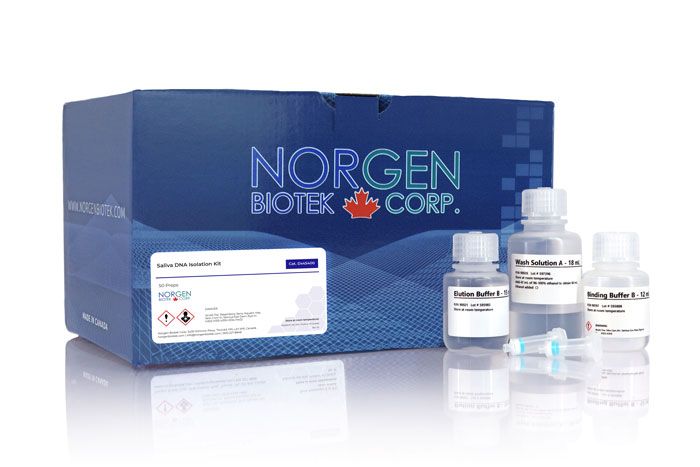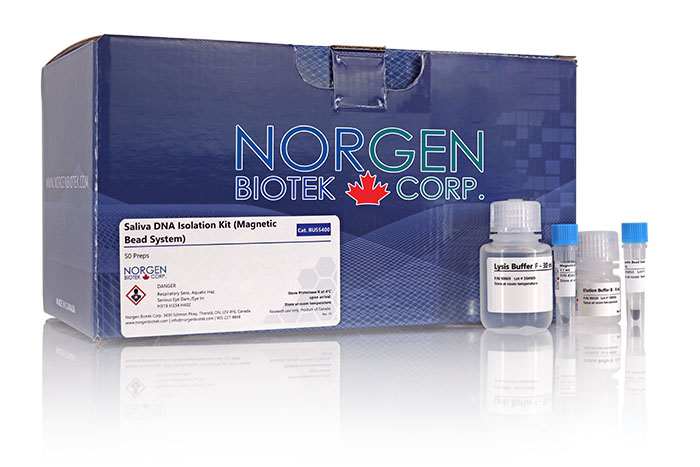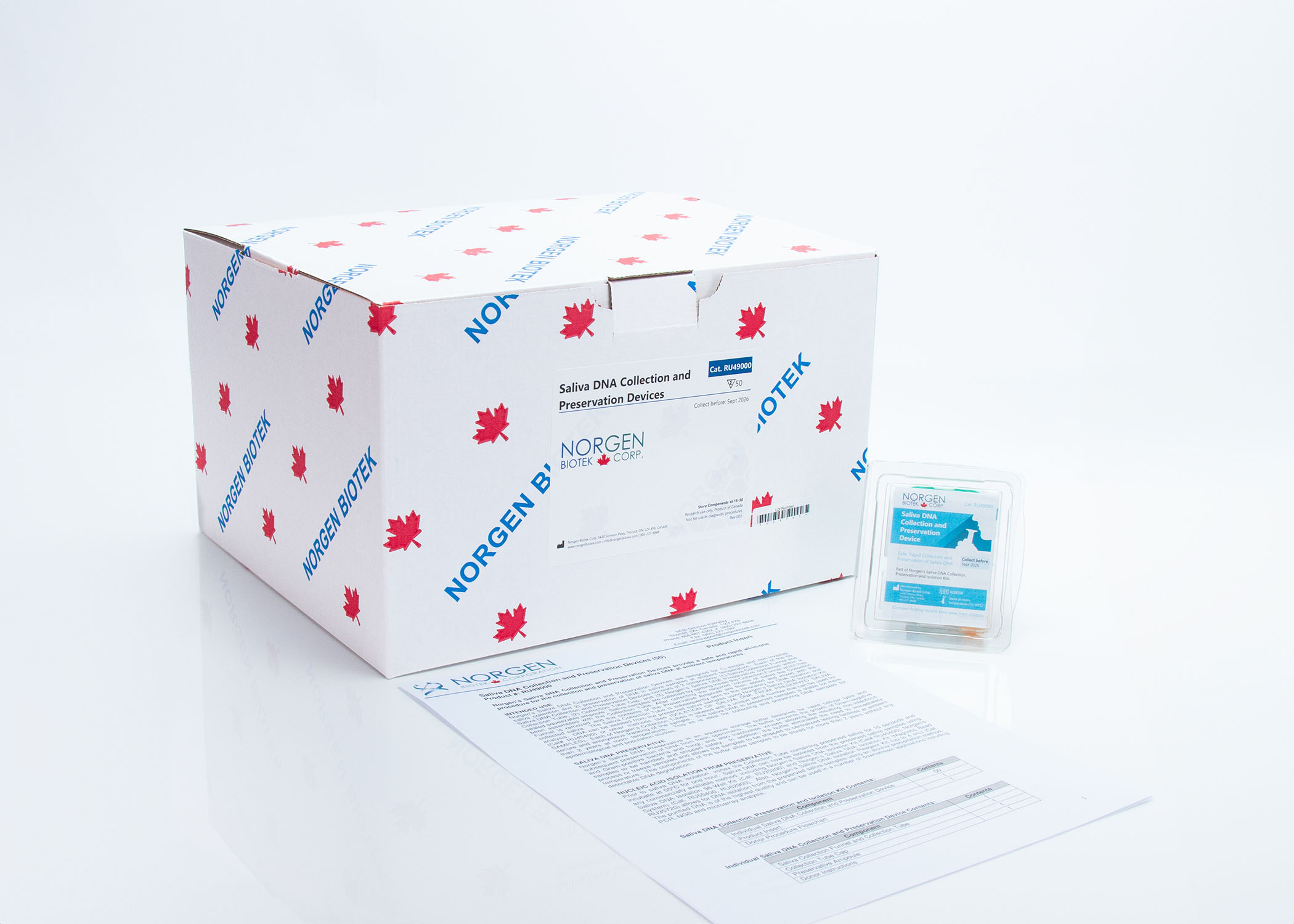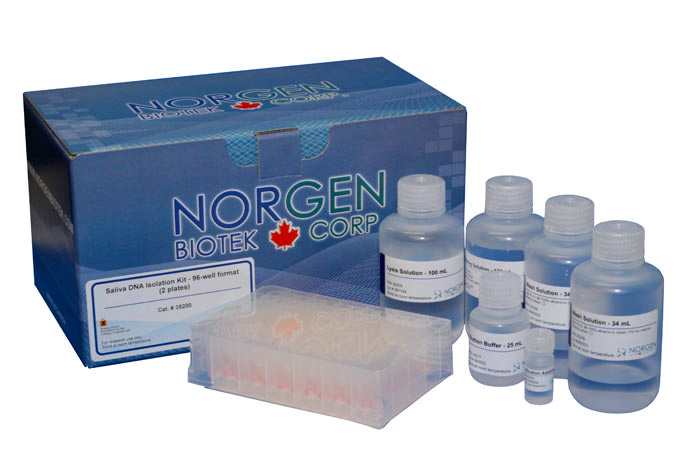Saliva DNA Isolation Kit Dx
For the rapid purification of high-quality DNA from preserved and fresh saliva samples for in vitro diagnostic use

Saliva DNA Isolation Kit Dx
For the rapid purification of high-quality DNA from preserved and fresh saliva samples for in vitro diagnostic use
Register today to receive an exclusive 15% off* on your first order.
Features and Benefits
- CE-IVDR marked in accordance with the European Commission Regulation (EU) No. 2017/746.
- Ideal for use in in vitro diagnostic workflows
- Sample collection is non-invasive and painless
- Fast and easy processing using a rapid spin-column format
- Isolate high quality genomic DNA to be used in downstream in vitro diagnostic applications
- Compatible with preserved saliva samples collected using Norgen’s Saliva DNA Collection and Preservation Devices, as well as fresh saliva samples
This kit provides a fast and simple spin column procedure for isolating genomic DNA from saliva samples collected and preserved using Norgen’s Saliva DNA Collection and Preservation Devices (Cat. 49000), as well as fresh saliva samples.
Saliva DNA purified using Norgen’s Saliva DNA Isolation Kit Dx kit is of the highest quality, and can be used with any downstream in vitro diagnostic application employing enzymatic amplification or other enzymatic modifications of DNA followed by signal detection or amplification.
Background
Saliva represents an excellent non-invasive alternative to blood collection. Human genomic DNA extracted from buccal epithelial cells and white blood cells found in saliva can be used in various applications in diagnostics. Saliva DNA can be used for the detection of biomarkers to diagnose a disease, follow the diseases progress or monitor the effects of a particular treatment. Saliva DNA can also be used to diagnose particular types of infections. Isolation of DNA from saliva has become an attractive alternative to isolation from blood or tissue due to the fact that sample collection is non-invasive, the samples can be collected by individuals with little training, and no special equipment is required. Norgen’s Saliva DNA Isolation Kit provides a fast and simple procedure for isolating genomic DNA from both preserved saliva samples and fresh saliva samples.
NOTE: This product is not available for sale in the United States.
Details
Supporting Data
Figure 1. High Quality and Yield of DNA from Saliva Samples. Total DNA was isolated from 250 µL of eight different fresh saliva samples using Norgen's Saliva DNA Isolation Kit Dx (Lanes 1-8). For evaluation, 10 µL of each 100 µL DNA elution was run on a 1.2 % agarose gel. Note the high yield and quality of the DNA in all lanes. Lane M: Norgen's Fast runner 1kb DNA Ladder.
Figure 2. Real-time PCR Consistency from Saliva Samples. Norgen's Saliva DNA Isolation Kit Dx was used to isolate DNA from 250 µL samples of fresh saliva. Ten samples were used from same donor. From the 100 µL elution, 5 µL of saliva DNA was added directly to a real-time PCR master mix (total reaction volume 20 µL), and the real-time PCR reaction was performed. The GAPDH gene was successfully amplified from the different samples without any inhibition and at the same Ct, indicating the isolation consistency and the excellent quality of saliva DNA for downstream applications.
Figure 3. Illumina MiSeq 16s rRNA metagenomics data from saliva samples preserved for over 6 years using Norgen's Saliva DNA Collection and Preservation Devices. The saliva DNA was isolated using Norgen's Saliva DNA Isolation Kit Dx (Cat. Dx45400) from saliva that had been preserved for various periods of time up to 6 years at room temperature. A) Principal Coordinate Analysis of 12 saliva microbiomes showing differences in the distribution of taxonomic classifications between samples up to kingdom level. B) Hierarchical clustering of 12 saliva microbiomes based on genus-level classifications, including a bar chart showing the relative abundance of genus-level classifications for each sample in the dendrogram.
|
Kit Specifications
|
|
|
Maximum Saliva Input
|
0.5 mL preserved saliva
0.25 mL fresh saliva |
|
Average Yield from 0.25 mL of Saliva*
|
3 - 7 μg
|
|
Average Purity (OD260/280)
|
1.7 - 2.1
|
| Time to Complete 10 Purifications |
30 minutes
|
* Average yield will depending on the donor
Storage Conditions and Product Stability
All solutions should be kept tightly sealed and stored at room temperature. All solutions and plastics can be used until the expiration date specified on their labels. The Proteinase K can be stored at either room temperature or 4oC.
| Component | Cat. Dx45400 (50 preps) |
|---|---|
| Lysis Solution | 30 mL |
| Proteinase K in Storage Buffer | 1.2 mL |
| Binding Solution | 12 mL |
| Wash Solution | 18 mL |
| Elution Buffer | 12 mL |
| Spin Columns | 50 |
| Collection Tubes | 50 |
| Elution Tubes (1.7 mL) | 50 |
| Product Insert | 1 |
Documentation
The Range of DNA Yield with Norgen’s Saliva DNA Collection, Preservation and Isolation Kit
A Comparative Study Between Two Saliva DNA Preservation Systems, and Two Column-Based Saliva DNA Purification Methods
The Effect of Elution Volume on DNA Quantity and Quality Using Norgen’s Saliva DNA Isolation Kit
Comparative Study of DNA Isolated from Saliva Preserved in Norgen’s Preservative Using Norgen’s Saliva DNA Isolation Kit Versus
Determination of the DNA Molecular Weight (MW) from different Norgen Columns and Isolation Methods
DNA Isolation from Saliva Preserved with Norgen’s Saliva DNA Collection and Preservation Device using Qiagen’s QIAamp DNA Blood
Linearity of DNA Isolated from Increasing Volumes of Preserved Saliva Using Norgen’s Saliva DNA Isolation Kit
Stability of DNA Stored in Norgen’s Saliva DNA Preservative for 52 Months at Room Temperature
Long Term Stability of DNA Stored in Norgen’s Saliva DNA Preservative
Citations
| Title | Elucidating causative gene variants in hereditary Parkinson's disease in the Global Parkinson's Genetics Program (GP2) |
| Citation | brief communications 2023. |
| Authors | Lara M. Lange, Micol Avenali, Melina Ellis, Anastasia Illarionova, Ignacio J. Keller Sarmiento, Ai-Huey Tan, Harutyun Madoev, Caterina Galandra, Johanna Junker, Karisha Roopnarain, Justin Solle, Claire Wegel, Zih-Hua Fang, Peter Heutink, Kishore R. Kumar, Shen-Yang Lim, Enza Maria Valente, Mike Nalls, Cornelis Blauwendraat, Andrew Singleton, Niccolo Mencacci, Katja Lohmann, Christine Klein & the Global Parkinson's Genetic Program |



